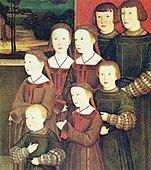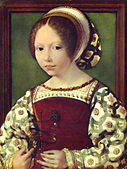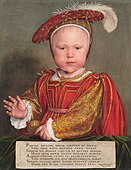Henry VIII of England (ruled 1509–1547) and Francis II of France (ruled 1515–1547) strove to host the most glittering renaissance court, culminating in the festivities around the Field of Cloth of Gold (1520). But the rising power was Charles V, king of Spain, Naples, and Sicily from 1516, heir to the style as well as the riches of Burgundy, and Holy Roman Emperor from 1530. The inflow of gold and silver from the New World into recently united Spain changed the dynamics of trade throughout Western Europe, ushering in a period of increased opulence in clothing that was tempered by the Spanish taste for sombre richness of dress that would dominate the second half of the century. This widespread adaptation of Hispanic court attire in Europe was seen as a sign of allegiance to the empire of Charles V.
Regional variations in fashionable clothing that arose in the 15th century became more pronounced in the sixteenth. In particular, the clothing of the Low Countries, German states, and Scandinavia developed in a different direction than that of England, France, and Italy, although all acknowledged the sobering and formal influence of Spanish dress after the mid-1520s.
Linen shirts and chemises or smocks had full sleeves and often full bodies, pleated or gathered closely at neck and wrist. The resulting small frill gradually became a wide ruffle, presaging the ruff of the latter half of the century. These garments were often decorated with embroidery in black or red silk, and occasionally with gold metal threads if the garment was meant to be flashier of ones wealth. The bodice was boned and stiffened to create a more structured form, and often a busk was inserted to emphasize the flattening and elongation of the torso. Small geometric patterns appeared early in the period and, in England, evolved into the elaborate patterns associated with the flowering of blackwork embroidery. German shirts and chemises were decorated with wide bands of gold trim at the neckline, which was uniformly low early in the period and grew higher by midcentury. Silk brocades and velvets in bold floral patterns based on pomegranate and thistle or artichoke motifs remained fashionable for those who could afford them, although they were often restricted to kirtles, undersleeves and doublets revealed beneath gowns of solid-coloured fabrics or monochromatic figured silks. Yellow and red were fashionable colors.
Inspired by the mended uniforms of the Swiss soldiers after the country's 1477 victory over the Duke of Burgundy, elaborate slashing remained popular, especially in Germany, where a fashion arose for assembling garments in alternating bands of contrasting fabrics. Elsewhere, slashing was more restrained, but bands of contrasting fabric called guards, whether in color or texture, were common as trim on skirts, sleeves, and necklines. These were often decorated with bands of embroidery or applied passementerie. Bobbin lace arose from passementerie in this period, probably in Flanders, and was used both as an edging and as applied trim; it is called passamayne in English inventories.
The most fashionable furs were the silvery winter coat of the lynx and dark brown (almost black) sable.
Women's fashion
Overview
Women's fashions of the early 16th century consisted of a long gown, usually with sleeves, worn over a kirtle or undergown, with a linen chemise or smock worn next to the skin.
The high-waisted gown of the late medieval period evolved in several directions in different parts of Europe. In the German states and Bohemia, gowns remained short-waisted, tight-laced but without corsets. The open-fronted gown laced over the kirtle or a stomacher or plackard. Sleeves were puffed and slashed, or elaborately cuffed.
In France, England, and Flanders, the high waistline gradually descended to the natural waist in front (following Spanish fashion) and then to a V-shaped point. Cuffs grew larger and were elaborately trimmed.
Hoop skirts or farthingales had appeared in Spain at the very end of the 15th century, and spread to England and France over the next few decades. Corsets also appeared during this period.
A variety of hats, caps, hoods, hair nets, and other headresses were worn, with strong regional variations.
Shoes were flat, with broad square toes.
German fashion
In the first half of the 16th century, German dress varied widely from the costume worn in other parts of Europe. Skirts were cut separately from bodices, though often sewn together, and the open-fronted gown laced over a kirtle with a wide band of rich fabric, often jeweled and embroidered, across the bust. Partlets (called in German gollers or collars) were worn with the low-cut bodice to cover the neck and shoulders, and were made in a variety of styles. The most popular goller was a round shoulder-capelet, frequently of black velvet lined in silk or fur, with a standing neckband; this goller would remain in use in some parts of Germany into the 17th century and became part of national dress in some areas.
Narrow sleeves were worn in the earliest years of the century, and were later decorated with bands of contrasting fabric and rows of small panes or strips over puffed linings. Skirts were trimmed with bands of contrasting fabric, but were closed all around. They would be worn draped up to display an underskirt.
From 1530, elements of Spanish dress were rapidly adopted in fashionable Germany under the influence of the imperial court of Charles V.
Gowns
Dress in Holland, Belgium, and Flanders, now part of the Empire, retained a high, belted waistline longest. Italian gowns were fitted to the waist, with full skirts below.
The French gown of the first part of the century was loosely fitted to the body and flared from the hips, with a train. The neckline was square and might reveal the kirtle and chemise beneath. Cuffed sleeves were wide at the wrist and grew wider, displaying a decorated undersleeve attached to the kirtle. The gown fastened in front early, sometimes lacing over the kirtle or a stomacher, and the skirt might be slit in front or the train tucked up in back to display the skirt of the kirtle.
As a fitted style emerged under Spanish influence, the gown was made as a separate bodice and skirt; this bodice usually fastened at the side or the side-back with hooks and eyes or lacing.
From the 1530s, French and English fashions featured an open, square-necked gown with long sleeves fitted smoothly over a tight corset or pair of bodies and a farthingale. With the smooth, conical line of the skirt, the front of the kirtle or petticoat was displayed, and a decorated panel called a forepart, heavily embroidered and sometimes jeweled, was pinned to the petticoat or directly to the farthingale.
The earlier cuffed sleeves evolved into trumpet sleeves, tight on the upper arm and flared below, with wide, turned back cuffs (often lined with fur) worn over full undersleeves that might match the decorated forepart. At the very end of the period, full round sleeves (perhaps derived from Italian fashions) began to replace the flaring trumpet sleeves, which disappeared by the later 1550s.
Fabric or chain girdles were worn at the waist and hung down to roughly knee length; a tassel or small prayer book or purse might be suspended from the girdle.
The low neckline of the dress could be filled with a partlet. Black velvet partlets lined in white with a high, flared neckline were worn pinned over the gown. Partlets of the same rich fabric as the bodice of the gown give the appearance of a high-necked gown. Sheer or opaque linen partlets were worn over the chemise or smock, and high-necked smocks began to appear; toward 1550 these might have a small standing collar with a ruffle, which would become the pleated ruff of the next period.
Hats and headgear
In France, England, and the Low Countries, black hoods with veils at the back were worn over linen undercaps that allowed the front hair (parted in the middle) to show. These hoods became more complex and structured over time.
Unique to England was the gable hood, a wired headdress shaped like the gable of a house. In the 16th century gable headdress had long embroidered lappets framing the face and a loose veil behind; later the gable hood would be worn over several layers that completely concealed the hair, and the lappets and veil would be pinned up in a variety of ways.
A simple rounded hood of the early years of the century evolved into the French hood, popular in both France and England; its arched shape sat further back on the head and displayed the front hair which was parted in the center and pinned up in braids or twists under the veil.
German women adopted hats like fashionable men's baretts early in the century; these were worn over caps or cauls (colettes) made of netted cord over a silk lining. Hats became fashionable in England as an alternative to the hood toward the 1540s. Close fitting caps of fur were worn in cold climates.
Linen caps called coifs were worn under the fur cap, hood or hat.
In warmer climates including Italy and Spain, hair was more often worn uncovered, braided or twisted with ribbons and pinned up, or confined in a net. A Spanish style of the later 15th century was still worn in this period: the hair was puffed over the ears before being drawn back at chin level into a braid or wrapped twist at the nape.
First-time brides wore their hair loose, in token of virginity, and a wreath or chaplet of orange blossoms was traditional. A jeweled wreath with enameled "orange blossoms" was sometimes worn.
Jewelry and accessories
Women of wealth wore gold chains and other precious jewelry; collar-like necklaces called carcanets, earrings, bracelets, rings, and jeweled pins. Bands of jeweler's work were worn as trim by the nobility, and would be moved from dress to dress and reused. Large brooches were worn to pin overpartlets to the dress beneath.
Dress hooks, of silver gilt for the wealthy and of base metal for the lower classes, were worn to loop up skirts.
A fashionable accessory was the zibellino, the pelt of a sable or marten worn draped at the neck or hanging at the waist; some costume historians call these "flea furs". The most expensive zibellini had faces and paws of goldsmith's work with jewelled eyes.
However, it should be noted that not all women or men were allowed to wear jewelry because of the sumptuary laws that restricted wearing certain types of jewelry and luxurious fabrics, such as purple velvet, to first royalty and then nobility. The newly wealthy merchant classes who were not aristocrats could not wear jewelry on their clothing or fabrics restricted to nobles.
Gloves of soft leather had short, sometimes slashed, cuffs and were perfumed.
Beauty Ideals
Portraits produced during the Renaissance provide an invaluable resource for visualizing and understanding the beauty ideals of the period. Sandro Botticelli’s Venus and Mars, painted between 1480-1490 depicts Venus as the ultimate amalgamation of female physical beauty. Her face is perfectly symmetrical, her skin is unblemished and pure white, her hair is light in color and slightly waved, her forehead is high, her eyebrows are severely arched, her lips are red and full and her abdomen and hips protrude slightly under her thin garment.
Women often applied toxic substances to their faces and chests such as mercury, alum, and ceruse to lighten the skin and remove freckles. However, these products, such as ceruse, a lead derivative severely irritated the skin, leaving women’s faces blemished and burned. Although safer alternatives existed, women preferred the consistency and coverage offered by ceruse. Not all cosmetics were dangerous, many women relied on lotions and balms containing almonds, olive oil, lemon juice, bread crumbs, eggs, honey, rosewater and snake fat to clarify and cleanse the skin. Red lips and rosy cheeks were achieved primarily through the application of vermilion; ceruse mixed with organic dyes such as henna and cochineal (a powder made from the ground exoskeleton of insects). In Italy especially, women sought to achieve the light tresses that were viewed as the ideal. Women applied mixtures of lemon juice, alum and white wine and sat in the sun to lighten their hair. In order to produce loose curls, women wrapped hair saturated in gum arabic or beer around clay curlers. Finally, the appearance of a high forehead was achieved by plucking hairs along the hairline, and severely arching or removing the eyebrows altogether. Although at this time, women could not cosmetologically alter the symmetry of their face, or the structure of their nose in order to obtain the ideal, the products available allowed them to come close.
Style gallery

1-1508
| 
2-1535
| 
3-1545
| 
4-1525
|
|---|
2.Anne Stafford wears a black fur-lined gown with turned-back sleeves over a dark kirtle She wears a soft sash at her waist and a sheer partlet over a square-necked chemise, c. 1535.
3.Portrait of Catherine Parr, sixth queen of Henry VIII. English or French fashion of 1545: the trumpet-sleeved "French" or "Tudor dress", worn over a farthingale and false undersleeves with a matching forepart. The turned-back cuffs are lined with fur.
4.Palma, Jacopo (il Vecchio) - La Bella - c. 1525
Men's fashion
Overview
Early in this period, men's silhouette was long and narrow, but gradually it grew wider until by the later reign of Henry the VIII the silhouette was almost square, with shoulder emphasis achieved through wide revers and collars and large sleeves.
Throughout this period, fashionable men's clothing consisted of:
A linen shirt or chemise, originally low-necked but with a higher neckline by mid-century. The neckline was gathered into a narrow band or adjusted by means of a drawstring; the tiny ruffle formed by pulling up the drawstring became wider over time, and then evolved into the ruff of the next period.
A doublet with matching sleeves, often slashed or cut to allow the fabric of the shirt beneath to show through.
A jerkin, usually cut low to the waist in front to reveal the doublet beneath, with full skirts to the knee.
Hose, now usually ending above the knee, with a prominent codpiece (both sometimes hidden under the skirts of the jerkin).
Separate nether-hose or stockings held up with garters.
A front-opening overgown, often fur-lined for warmth and slashed, with sleeves. The overgown was ankle length early in the period, but knee-length overgowns were fashionable in the 1530s and 1540s. Scholars, judges, doctors, and other professionals retained the ankle length gown throughout the period.
From the 1530s, a narrower silhouette became popular under Spanish influence. Collars were higher and tighter. Shoulders lost their padding and developed a slight slope. Doublet sleeves became fuller rather than tight. Jerkins closed to the neck; their skirts were shorter and slightly flared rather than full, and they displayed more of the hose. Overall the fashion was more rigid and restrained.
Lower class men wore a one-piece garment called a cotte in English, tight to the waist with knee-length skirts and long sleeves over their hose.
Bright colors (reds, yellows, purples, pinks, and greens) were popular.
Matthäus Schwarz compiled a Klaidungsbüchlein or Trachtenbuch (usually translated as "Book of Clothes"), a book cataloguing the clothing that he wore between 1520 and 1560. The book contains color illustrations focused on Schwarz's individual clothing history.
Hairstyles and headgear
A variety of hats were worn in the period. The German 'barett, with its turned-up brim, was fashionable throughout the period, and a similar hat with a turned-up round or "halo" brim was popular in the court of Henry VIII. The flat hat combined a low, gathered crown with a circular brim and was worn in mid-century.
Style gallery

1-1537
| 
2 – 1510
| 
3 – 1512
| 
4 – 1520–25
|
|---|
2.Italian youth wears striped hose, a doublet with puffed upper sleeves, and a voluminous cloak, 1510.
3.The Swiss Guard at the Vatican wear full-skirted giornea or jerkins and full sleeves over low-necked shirts or chemises, 1512.
4.Francis I of France wears a wide-necked doublet with paned sleeves under dark gold jerkin and a satin overgown with turned-back sleeves. His shirt has a tiny frill edged in black at the neck and wide ruffles at the wrist. Jean Clouet, c. 1520–25.
Footwear
Style in men's and women's footwear was the same in this period. Shoes for men and women were flat, and often slashed and fastened with a strap across the instep. They were made of soft leather, velvet, or silk. Broad, squared toes were worn early, and were replaced by rounded toes in the 1530s. Toward the middle of the century, shoes became narrower and were shaped naturally to the foot. Soft boots for riding fitted to mid-calf.
Children's fashion

German, 1517
| 
French, 1520–35
| 
England, 1538
| 
Italy, 1545
|
|---|
As shown in the images below, children's clothing was mostly smaller versions of adult clothing, complete with low necklines and cumbersome underthings. Children of the nobility must have had limited freedom of movement to play and romp because of the restrictive clothing they wore. Toddler boys wore gowns until they were breeched.
Working class clothing

1 – 1505
| 
2 – 1510
| 
3 – 1510
| 
4 – 1510
|
|---|
1.Bavarian stonemasons wear knee-length tunics, hose, and ankle-high shoes, c. 1505.
2.Sheep shearers wear short tunics over shirts, with hose and ankle-high shoes, Flanders, c. 1510.
3.Haymakers: Barefoot women wear short-sleeved, front-laced dresses with contrasting linings tucked up over knee-length chemises, with aprons and straw hats. 4.Men wear sleeveless overgowns or jerkins over their shirts and hose, c. 1510.
The prodigal son is dressed like a beggar, in undyed or faded clothing. He wears a hood and carries a hat with a brim and a wicker pack on his back, c. 1510.
Source from Wikipedia
没有评论:
发表评论